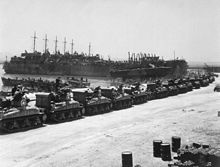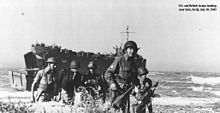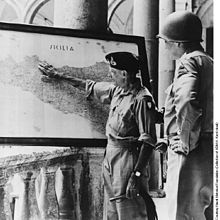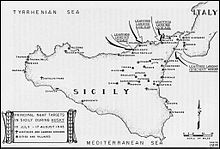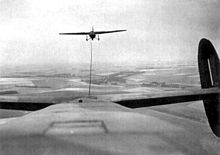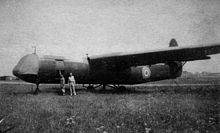- Operation Husky order of battle
-
Operation Husky Order of Battle is a listing of the significant formations that were involved in the campaign for Sicily, July 10 – August 17, 1943.
Allied Forces
Allied Forces Headquarters - Mediterranean
Supreme Commander: General Dwight D. EisenhowerCommanded by Admiral Andrew Cunningham
- Western Naval Task Force
Commanded by Vice Admiral H.K. Hewitt - Eastern Naval Task Force
Commanded by Vice Admiral B.L. Ramsay
Allied 15th Army Group
Under the command of General Sir Harold Alexander.
U.S. 7th Army
Commanded by Lieutenant General George Smith Patton.
- 1st Ranger Battalion
- 3rd Ranger Battalion
- 4th Ranger Battalion
- 70th Tank Battalion
- 753rd Tank Battalion
- 601st Tank Destroyer Battalion
- 813th Tank Destroyer Battalion-2 platoons
- 39th Engineer Regiment
- 540th Engineer Shore Regiment
- 5th Armored Artillery Group
- 58th Armored Field Artillery Battalion
- 62nd Armored Field Artillery Battalion
- 65th Armored Field Artillery Battalion
- 17th Artillery Regiment
- 36th Artillery Regiment
- 77th Artillery Regiment
- 178th Artillery Regiment
- Free French 4th Morrocan Tabor
U.S. II Corps
Commanded by Lieutenant General Omar Nelson Bradley.
- U.S. 1st Infantry Division
Initially commanded by Major General Terry de la Mesa Allen. He was succeeded by Major General Clarence R. Huebner on August 7.- 16th Infantry Regiment
- 18th Infantry Regiment
- 26th Infantry Regiment
- 5th Field Artillery Battalion
- 7th Field Artillery Battalion
- 32d Field Artillery Battalion
- 33d Field Artillery Battalion
- 1st Engineer Combat Battalion
- 1st Reconnaissance Troop
- U.S. 9th Infantry Division
Commanded by Major General Manton Sprague Eddy.- 39th Infantry Regiment
- 47th Infantry Regiment
- 60th Infantry Regiment
- 26th Field Artillery Battalion
- 34th Field Artillery Battalion
- 60th Field Artillery Battalion
- 84th Field Artillery Battalion
- 15th Engineer Combat Battalion
- 42nd Anti-Aircraft Battalion
- 9th Reconnaissance Troop
- U.S. 45th Infantry Division
Commanded by Major General Troy Houston Middleton.- 157th Infantry Regiment
- 179th Infantry Regiment
- 180th Infantry Regiment
- 158th Field Artillery Battalion
- 160th Field Artillery Battalion
- 171st Field Artillery Battalion
- 189th Field Artillery Battalion
- 645th Tank Destroyer Battalion
- 120th Engineer Combat Battalion
- 45th Reconnaissance Troop
U.S. Provisional Corps
(HQ activated 15 July)[1] Commanded by Major General Geoffrey Keyes.
- U.S. 2d Armored Division
Commanded by Major-General Hugh J. Gaffey. Divisional units were placed under the Combat Commands as needed.- Combat Command A
- Combat Command B
- 41st Armored Infantry Regiment
- 66th Armored Regiment
- 67th Armored Regiment
- 14th Armored Field Artillery Battalion
- 78th Armored Field Artillery Battalion
- 92d Armored Field Artillery Battalion
- 17th Armored Engineer Battalion
- 82d Armored Reconnaissance Battalion
- U.S. 3d Infantry Division
Commanded by Major General Lucian King Truscott, Jr.- 7th Infantry Regiment
- 15th Infantry Regiment
- 30th Infantry Regiment
- 9th Field Artillery Battalion
- 10th Field Artillery Battalion
- 39th Field Artillery Battalion
- 41st Field Artillery Battalion
- 10th Engineer Combat Battalion
- U.S. 82nd Airborne Division
Commanded by Major General Matthew Bunker Ridgway. The 509th Parachute Battalion was held in reserve and never saw action.- 504th Parachute Infantry Regiment
- 505th Parachute Infantry Regiment
- 325th Glider Infantry Regiment
- 376th Parachute Field Artillery Battalion
- 456th Parachute Field Artillery Battalion
- 319th Glider Field Artillery Battalion
- 320th Glider Field Artillery Battalion
- 307th Airborne Engineer Battalion
- 80th Airborne Anti-Aircraft Battalion
British 8th Army
Under the command of General Bernard Law Montgomery. The British 46th Infantry Division formed a floating reserve, but did not participate in the Sicily campaign.
Army Troops
- 2nd Special Air Service
- No. 3 Commando
- 40 (Royal Marine) Commando
- 41 (Royal Marine) Commando
- 3 companies 2nd/7th Battalion, The Middlesex Regiment (Duke of Cambridge's Own)
- 2nd/4th Battalion, The Hampshire Regiment
- 1st Battalion, Argyll and Sutherland Highlanders
- 2nd Battalion, The Highland Light Infantry
- 1st Battalion, The Welch Regiment
- 7th Battalion, Royal Marines
British XIII Corps
Commanded by Lieutenant-General Miles Dempsey.
- 105th Anti-Tank Regiment, Royal Artillery
- 6th Army Group Royal Artillery
- 24th Armoured Field Regiment, Royal Artillery
- 98th Armoured Field Regiment, Royal Artillery
- 111th Field Regiment, Royal Artillery
- 66th Medium Regiment, Royal Artillery
- 75th Medium Regiment, Royal Artillery
- 80th Medium Regiment, Royal Artillery
- British 5th Infantry Division[2]
Commanded by Major-General Horatio Pettus Mackintosh Berney-Ficklin (succeeded by Gerard Bucknall on 3 August[3]).- 13th Infantry Brigade
- 2nd Battalion Cameronians (Scottish Rifles)
- 2nd Battalion Royal Inniskilling Fusiliers
- 2nd Battalion Wiltshire Regiment
- 15th Infantry Brigade
- 1st Battalion Green Howards
- 1st Battalion Kings Own Yorkshire Light Infantry
- 1st Battalion York and Lancaster Regiment
- 17th Infantry Brigade
- 2nd Battalion Royal Scots Fusiliers
- 2nd Battalion Northamptonshire Regiment
- 6th Battalion Seaforth Highlanders
- 91st Field Regiment, Royal Artillery
- 92nd Field Regiment, Royal Artillery
- 156th Field Regiment, Royal Artillery
- 52nd Anti-Tank Regiment, Royal Artillery
- 18th Light Anti Aircraft Regiment, Royal Artillery
- 5th Reconnaissance Regiment
- 7th Battalion, The Cheshire Regiment (Machine Gun battalion)
- 38th, 245th and 252nd Field Companies, Royal Engineers
- 245th Field Park Company, Royal Engineers
- 13th Infantry Brigade
- British 50th (Northumbrian) Infantry Division[4]
Commanded by Major-General Sidney Kirkman.- 69th Infantry Brigade
- 5th Battalion East Yorkshire Regiment
- 6th Battalion Green Howards
- 7th Battalion Green Howards
- 151st Infantry Brigade
- 6th Battalion Durham Light Infantry
- 8th Battalion Durham Light Infantry
- 9th Battalion Durham Light Infantry
- 168th Infantry Brigade
- 1st Battalion London Irish Regiment
- 1st Battalion London Scottish Regiment
- 10th Battalion Royal Berkshire Regiment
- 74th Field Regiment, Royal Artillery
- 90th Field Regiment, Royal Artillery
- 124th Field Regiment, Royal Artillery
- 102nd (Northumberland Hussars) Anti-Tank Regiment, Royal Artillery
- 25th Light Anti-Aircraft Regiment, Royal Artillery
- 2nd Battalion The Cheshire Regiment (MG)
- 233rd, 501st and 505th Field Companies, Royal Engineers
- 69th Infantry Brigade
- British 78th Infantry Division[5]
Commanded by Major-General Vyvyan Evelegh.- 11th Infantry Brigade
- 2nd Battalion Lancashire Fusiliers
- 1st Battalion East Surrey Regiment
- 5th Battalion Northamptonshire Regiment
- 36th Infantry Brigade
- 6th Battalion Royal West Kent Regiment
- 5th Battalion Buffs (Royal East Kent Regiment)
- 8th Battalion Argyll & Sutherland Highlanders
- 38th (Irish) Infantry Brigade
- 6th Battalion Royal Iniskilling Fusiliers
- 1st Battalion Royal Irish Fusiliers
- 2nd Battalion London Irish Rifles
- 56th Reconnaissance Regiment, Royal Armoured Corps
- 17th Field Regiment, Royal Artillery
- 132nd Field Regiment, Royal Artillery
- 138th Field Regiment, Royal Artillery
- 64th Anti-Tank Regiment, 142nd Field Regiment, RA
- 49th Light Anti-Aircraft Regiment, Royal Artillery
- 1st Battalion, Kensington Regiment (Princess Louise's) (Machine Gun)
- 214th, 237th and 256th Field Companies, Royal Engineers
- 281st Field Park Company, Royal Engineers
- 11th Infantry Brigade
- British 1st Airborne Division
Commanded by Major-General George F. Hopkinson. Did not participate as a division.- British 1st Airlanding Brigade[6]
- 1st Battalion The Border Regiment
- 2nd Battalion South Staffordshire Regiment
- 9th Field Company, Royal Engineers
- British 1st Parachute Brigade[7]
- 1st Battalion Parachute Regiment
- 2nd Battalion Parachute Regiment
- 3rd Battalion Parachute Regiment
- 16th (Parachute) Field Ambulance
- 1st Airlanding Anti-tank Battery, Royal Artillery
- British 1st Airlanding Brigade[6]
- British 4th Armoured Brigade[8]
- 3rd County of London Yeomanry (The Sharpshooters)
- 44th Royal Tank Regiment
- A Squadron, 1st (Royal) Dragoons
British XXX Corps
Commanded by Lieutenant-General Sir Oliver Leese.
- 73rd Anti-Tank Regiment, Royal Artillery
- 5th Army Group Royal Artillery
- 57th Field Regiment, Royal Artillery
- 58th Field Regiment, Royal Artillery
- 78th Field Regiment, Royal Artillery
- 7th Medium Regiment, Royal Artillery
- 64th Medium Regiment, Royal Artillery
- 70th Medium Regiment, Royal Artillery
- 11th (Honourable Artillery Company) Royal Horse Artillery
- 142nd Armoured Field Regiment, Royal Artillery
- 1st Canadian Infantry Division[9]
Commanded by Major-General Guy Granville Simonds.- 1st Canadian Infantry Brigade
- The Royal Canadian Regiment
- Hastings and Prince Edward Regiment
- 48th Highlanders of Canada
- 2nd Canadian Infantry Brigade
- Princess Patricia's Canadian Light Infantry
- Seaforth Highlanders of Canada
- Loyal Edmonton Regiment
- 3rd Canadian Infantry Brigade
- Royal 22e Régiment
- Carleton and York Regiment
- West Nova Scotia Regiment
- 1st Field Regiment, Royal Canadian Horse Artillery
- 2nd Field Regiment, Royal Canadian Artillery
- 3rd Field Regiment, Royal Canadian Artillery
- The Saskatoon Light Infantry (Machine Gun)
- 1st Anti-Tank Regiment, Royal Canadian Artillery
- 2nd Light Anti-Aircraft Regiment, Royal Canadian Artillery
- 4th Reconnaissance Regiment (4th Princess Louise Dragoon Guards)
- No. 1 Defence and Employment Platoon (Lorne Scots)
- 1st, 3rd and 4th Field Companies , Royal Canadian Engineers
- 2nd Field Park Company, Royal Canadian Engineers
- 1st Canadian Infantry Brigade
- 1st Canadian Army Tank Brigade[9]
- 11th Armoured Regiment (The Ontario Regiment)
- 12th Armoured Regiment (The Three Rivers Regiment)
- 14th Armoured Regiment (The Calgary Regiment)
- British 51st (Highland) Infantry Division[10]
Commanded by Major-General Douglas Wimberley.- 152nd Infantry Brigade
- 5th Battalion Queen's Own Cameron Highlanders
- 2nd Battalion Seaforth Highlanders
- 5th Battalion Seaforth Highlanders
- 153rd Infantry Brigade
- 5th Battalion Black Watch
- 1st Battalion Gordon Highlanders
- 5/7th Battalion Gordon Highlanders
- 154th Infantry Brigade
- 1st Battalion Black Watch
- 7th Battalion Black Watch
- 7th Battalion Argyll & Sutherland Highlanders
- 126th Field Regiment, Royal Artillery
- 127th Field Regiment, Royal Artillery
- 128th Field Regiment, Royal Artillery
- 61st Anti-Tank Regiment, Royal Artillery
- 40th Light Antiaircraft Regiment, Royal Artillery
- 1st/7th Battalion, The Middlesex Regiment (Duke of Cambridge's Own) (Machine Gun battalion)
- 7th Battalion Royal Marines (under command 19 to 29 July)
- 274th 275th and 275th Field Companies, Royal Engineers
- 239th Field Park Company, Royal Engineers
- 152nd Infantry Brigade
- British 23rd Armoured Brigade[11]
HQ 23rd Armoured Brigade HQ fought as Arrow Force in mid July with 2nd battalion Seaforth Highlanders (from 152nd Brigade) under command together with elements of 50th RTR and 11th (HAC) Regiment, Royal Horse Artillery as well as an anti-tank battery and a machine gun company.[10]- 50th Royal Tank Regiment
- 46th Royal Tank Regiment
- 40th Royal Tank Regiment
- 11th Battalion Kings Royal Rifle Corps
- British 231st Infantry Brigade[12]
- 2nd Battalion, The Devonshire Regiment
- 1st Battalion, The Dorsetshire Regiment
- 1st Battalion, The Hampshire Regiment
- 165th Field Regiment, Royal Artillery
- 295th Field Company, Royal Engineers
Allied Air Forces
At the time of Operation Husky, the Allied air forces in the North African and Mediterranean Theaters were organized as the Mediterranean Air Command (MAC) under Air Chief Marshal Sir Arthur Tedder. The major sub-command of MAC was the Northwest African Air Forces (NAAF) under the command of Lieutenant General Carl Spaatz. NAAF consisted primarily of units from the United States 12th Air Force (also under Spaatz), the US 9th Air Force under Lieutenant General Lewis H. Brereton, and the British Royal Air Force (RAF). In addition to NAAF, Middle East Command, AHQ Malta, RAF Gibraltar, and No. 216 (Transfer and Ferry) Group, were major sub-commands of MAC under Tedder who reported to the Supreme Allied Commander Dwight D. Eisenhower for the Allied NAAF operations, but to the British Chiefs of Staff for the RAF Command operations. AHQ Malta under Air Vice-Marshal Sir Keith Park provided key air support during Operation Husky. A Desert Air Task Force consisting of B-25 Mitchell medium bombers (12th and 340th Bombardment Groups) and P40 Warhawk fighters (57th, 79th, and 324th Fighter Groups) from the U.S. 9th Air Force operated under Air Marshal Sir Arthur Coningham's Northwest African Tactical Air Force and these groups moved to airfields on Sicily soon after the invasion. In the MAC organization established at the Casablanca Conference in January 1943, the U.S. 9th Air Force was a sub-command of Middle East Command under Air Chief Marshal Sir Sholto Douglas.[13][13][14][15][16]
Mediterranean Air Command (Allied)
Air Chief Marshal Sir Arthur Tedder, Headquarters at Algiers, Algeria[17]
Northwest African Air Forces
Lieutenant General Carl Spaatz, Headquarters at Maison Carree, Algeria[17]
Northwest African Strategic Air Force
Major General James H. Doolittle,
Headquarters at Constantine, Algeria[17]See also: Northwest African Strategic Air Force- 5th Bombardment Wing (Heavy)
Northwest African Coastal Air Force
Air Vice-Marshal Sir Hugh Lloyd, Headquarters at Algiers, Algeria[17]
See also: Northwest African Coastal Air Force- No. 242 Group RAF[18] (Air Commodore Kenneth Cross)
- No. 323 Wing RAF
- No. 73 Squadron, Spitfire
- No. 255 Squadron, Beaufighter
- No. II/5 Escadre (French), P-40
- No. II/7 Escadre (French), Spitfire
- No. 283 Squadron, Walrus (Air Sea Rescue)
- No. 284 Squadron, Walrus (Air Sea Rescue)
- No. 328 Wing
- No. 14 Squadron, B-26 Marauder
- No. 39 Squadron, Beaufort
- No. 47 Squadron, Beaufort
- No. 144 Squadron, Beaufighter
- No. 52 Squadron Baltimore
- No. 221 Squadron (Det.), Wellington
- No. 458 Squadron (RAAF), Wellington
- No. 323 Wing RAF
Source[19][20] British Units American Units RAF Units - No. 13 Squadron, Blenheim
- No. 614 Squadron, Blenheim
- No. 36 Squadron, Wellington
- No. 253 Squadron, Hurricane
- No. 274 Squadron Hurricane
- No. 313 Squadron, Hurricane
- No. 500 Squadron, Hudson
- No. 608 Squadron, Hudson
- No. 1575 Flight, Halifax, Ventura
52nd Fighter Group
Lieutenant Colonel James Coward- 2nd Squadron, Spitfire
- 4th Squadron, Spitfire
- 5th Squadron, Spitfire
- 414th Nightfighter Squadron, Beaufighter
- 415th Nightfighter Squadron, Beaufighter
Royal Navy Fleet Air Arm Units
Torpedo Spotter Reconnaissance81st Fighter Group
Lieutenant Colonel Michael Gordon
Oran, Algeria Sector:
92nd Squadron, P-39 Airacobra 1st Air Defense Wing:
91st Squadron, P-39 Airacobra
93rd Squadron, P-39 AiracobraBone, Algeria Sector: - No. 32 Squadron, Hurricane
- No. 87 Squadron, Hurricane
- No. 219 Squadron, Beaufighter
350th Fighter Group
Lieutenant Colonel Marvin McNickle- 345th Squadron, P-39 Airacobra
- 346th Squadron, P-39 Airacobra
- 347th Squadron, P-39 Airacobra
2nd Air Defense Wing:
No. 153 Squadron, Beaufighter
480th Antisubmarine Group
Colonel Jack Roberts- 1st Squadron, B-24 Liberator
- 2nd Squadron, B-24 Liberator
Notes:
- The 1st and 2nd Antisubmarine Squadrons were assigned to NACAF for administration and placed under the operational control of United States Navy Fleet Air Wing 15 of the Moroccan Sea Frontier commanded by Rear Admiral Frank J. Lowry
- Air Ministry was asked to provide two additional Wellington squadrons.[clarification needed]
Northwest African Tactical Air Force
Air Marshal Sir Arthur Coningham, Headquarters at Hammamet, Tunisia[17]
See also: Northwest African Tactical Air ForceAir Vice Marshal Harry Broadhurst
-
- No. 7 Wing (SAAF)
- No. 2 Squadron SAAF, Supermarine Spitfire
- No. 4 Squadron SAAF, Spitfire
- No. 5 Squadron SAAF, Curtiss Kittyhawk
- No. 7 Wing (SAAF)
-
- No. 239 (Fighter) Wing RAF, Kittyhawk
-
- No. 244 (Fighter) Wing RAF, Spitfires
- No. 1 Squadron SAAF
- No. 92 Squadron RCAF
- No. 145 Squadron RCAF
- No. 417 Squadron RCAF
- No. 601 Squadron RAF
- No. 244 (Fighter) Wing RAF, Spitfires
-
- No. 322 (Fighter) Wing RAF, Colin Falkland Gray, Spitfires
- No. 324 (Fighter) Wing RAF, Spitfires
- 57th Fighter Group (USAAF)
Colonel Arthur Salisbury- 64th Squadron, P-40 Warhawk
- 65th Squadron,[21] P-40 Warhawk
- 66th Squadron, P-40 Warhawk
- 79th Fighter Group (USAAF)
Colonel Earl Bates- 85th Squadron, P-40 Warhawk
- 86th Squadron, P-40 Warhawk
- 87th Squadron, P-40 Warhawk
- No. 285 (Reconnaissance) Wing RAF
- No. 40 Squadron SAAF, Det., Spitfire
- No. 60 Squadron SAAF, Mosquito
- No. 1437 Flight RAF, Mustang
- No. 6 Squadron, Hurricane ground attack
-
- 27th Fighter-Bomber Group (USAAF)
Lieutenant Colonel John Stevenson- 522nd Squadron, A-36 Mustang
- 523rd Squadron, A-36 Mustang
- 524th Squadron, A-36 Mustang
- 86th Fighter-Bomber Group (USAAF)
Major Clinton True- 525th Squadron, A-36 Mustang
- 526th Squadron, A-36 Mustang
- 527th Squadron, A-36 Mustang
- 33d Fighter Group (USAAF)
Colonel William Momyer- 58th Squadron, P-40 Warhawk
- 59th Squadron, P-40 Warhawk
- 60th Squadron, P-40 Warhawk
- 99th Squadron, P-40, Detached
- 324th Fighter Group (USAAF)
Colonel William McNown- 314th Squadron, P-40 Warhawk
- 315th Squadron, P-40 Warhawk
- 316th Squadron, P-40 Warhawk
- 31st Fighter Group (USAAF)
Lieutenant Colonel Frank Hill- 307th Squadron, Spitfire
- 308th Squadron, Spitfire
- 309th Squadron, Spitfire
- 111th Tactical Reconnaissance Squadron, Mustang
- 27th Fighter-Bomber Group (USAAF)
-
- Tactical Bomber Force
Air Commodore Laurence Sinclair[22][23]
-
- No. 3 Wing SAAF
- No. 12 Squadron SAAF, Boston
- No. 21 Squadron SAAF, Baltimore
- No. 24 Squadron SAAF, Boston
- No. 232 (Light Bomber) Wing RAF
- No. 55 Squadron RAF, Baltimore
- No. 223 Squadron RAF, Baltimore
- 33d Fighter Group (USAAF)
Colonel William Momyer- 58th Squadron, P-40 Warhawk
- 59th Squadron, P-40 Warhawk
- 60th Squadron, P-40 Warhawk
- 99th Squadron, P-40, Detached
- No. 326 (Light Bomber) Wing RAF
- No. 18 Squadron RAF, Boston
- No. 114 Squadron RAF, Boston
- 47th Bombardment Group (USAAF)
Colonel Malcolm Green, Jr.- 84th Squadron, A-20 Havoc
- 85th Squadron, A-20 Havoc
- 86th Squadron, A-20 Havoc
- 97th Squadron, A-20 Havoc
- 31st Fighter Group (USAAF)
Lieutenant Colonel Frank Hill- 307th Squadron, Spitfire
- 308th Squadron, Spitfire
- 309th Squadron, Spitfire
- 12th Bombardment Group (USAAF)
Colonel Edward Backus- 81st Squadron, B-25 Mitchell
- 82nd Squadron, B-25 Mitchell
- 83rd Squadron, B-25 Mitchell
- 434th Squadron, B-25 Mitchell
- 340th Bombardment Group (USAAF)
Lieutenant Colonel Adolph Tokaz- 486th Squadron, B-25 Mitchell
- 487th Squadron, B-25 Mitchell
- 488th Squadron, B-25 Mitchell
- 489th Squadron,[24] B-25 Mitchell
- No. 225 Squadron RAF, Spitfire
- No. 241 Squadron RAF, Hurricane
- No. 3 Wing SAAF
For Operation Husky, No. 242 Group, originally a component of NATAF in February 1943, was assigned to the Northwest African Coastal Air Force (NACAF). At the same time, Air Headquarters, Western Desert became known as the Desert Air Force. All of the fighter units of Desert Air Force formed No. 211 (Offensive Fighter) Group commanded by Air Commodore Richard Atcherley on April 11, 1943 in Tripoli. The 99th Fighter Squadron was assigned to the XII Air Support Command on May 28, 1943 and subsequently attached to the 33rd Fighter Group.
Northwest African Troop Carrier Command
Brigadier General Paul Williams, Tunisia
See also: Northwest African Troop Carrier Command51st Troop Carrier Wing
Brig. Gen. Ray Dunn52nd Troop Carrier Wing
Colonel Harold ClarkRAF Detachment 60th Troop Carrier Group
Lt. Col. Frederick Sherwood
10th Squadron, C-47
11th Squadron, C-47
12th Squadron, C-47
28th Squadron, C-4761st Troop Carrier Group
Colonel Willis Mitchell-
- 14th Squadron, C-47
- 15th Squadron, C-47
- 53rd Squadron, C-47
- 59th Squadron, C-47
No. 38 Wing Air Commodore William Primrose
-
- No. 295 Squadron RAF (Det.), Halifax
- No. 296 Squadron RAF, Albemarle
62nd Troop Carrier Group
Lt. Col. Aubrey Hurren
4th Squadron, C-47
7th Squadron, C-47
8th Squadron, C-47
51st Squadron, C-47313th Troop Carrier Group
Colonel James Roberts Jr.
29th Squadron, C-47
47th Squadron, C-47
48th Squadron, C-47
49th Squadron, C-4764th Troop Carrier Group
Colonel John Cerny
16th Squadron, C-47
17th Squadron, C-47
18th Squadron, C-47
35th Squadron, C-47314th Troop Carrier Group
Colonel Clayton Stiles
32nd Squadron, C-47
50th Squadron, C-47
61st Squadron, C-47
62nd Squadron, C-47Information in table taken from:
1) Participation of the Ninth &
Twelfth Air Forces in the Sicilian
Campaign, Army Air Forces Historical
Study No. 37, Army Air Forces
Historical Office Headquarters,
Maxwell AFB, Alabama, 1945.316th Troop Carrier Group
Colonel Jerome McCauley
36th Squadron,[25] C-47
44th Squadron, C-47
45th Squadron, C-47Information in table taken from:
2) Maurer, Maurer, Air Force
Combat Units Of World War II,
Office of Air Force History,
Maxwell AFB, Alabama, 1983.In mid-1943, to facilitate transport and supply operations for Operation Husky, the USAAF 315th Troop Carrier Group (34th & 43rd Squadrons) had been sent from England to Tunisia and assigned to the Mediterranean Air Transport Service which along with NATCC, was a sub-command of the Mediterranean Air Command.
Northwest African Photographic Reconnaissance Wing
Colonel Elliott Roosevelt, Headquarters at La Marsa, Tunisia
- Northwest African Photographic Reconnaissance Wing
- 3rd Photographic Group, Lieutenant Colonel Frank Dunn
- 5th Combat Mapping Squadron, P-38 Lightning
- 12th Photographic Reconnaissance Squadron, P-38 Lightning
- 12th Weather Detachment
- 15th Photographic Reconnaissance Squadron, B-17 Fortress
- 13th Photographic Reconnaissance Squadron Photo Intelligence
- No. 60 Squadron SAAF Det., Mosquito PR
- No. 540 Squadron RAF Det., Mosquito PR
- No. 680 Squadron RAF, Spitfire PR
- 2/33 Groupe (French), P-38 Lightning
- 3rd Photographic Group, Lieutenant Colonel Frank Dunn
Northwest African Air Service Command
Brigadier General Delmar Dunton, Algiers, Algeria[17]
See also: Northwest African Air Service CommandNorthwest African Training Command
Brigadier General John K. Cannon,
U.S. APO 525[17]See also: Northwest African Training CommandAir Headquarters Malta
Air Vice-Marshal Keith Park, Headquarters at Valletta, Malta[26]
See also: AHQ Malta- No. 248 (Naval Co-operation) Wing
- Spitfire fighter units
- No. 40 Squadron SAAF, reconnaissance unit
- No 126 (Persian Gulf) Squadron RAF
- No. 185 Squadron RAF
- No. 229 Squadron RAF
- No. 249 Squadron RAF
- No. 1435 Flight RAF
- Other units
- No. 23 Squadron RAF, Nght intruder operations with de Havilland Mosquito
- No. 73 Squadron RAF Det., Hurricane IIC
- No. 256 Squadron RAF Det., Mosquito XII night fighters
- No. 600 (City of London) Squadron RAF, Beaufighter night fighter/night intruder
- 815 Naval Air Squadron Det. (Fleet Air Arm), Fairey Albacore
Notes: SAAF=South African Air Force; Det.=Detachment.
No. 216 (Transport and Ferry) Group
Air Commodore Whitney Straight, Headquarters at Heliopolis, Egypt[26]
See also: No. 216 Group RAF- No. 17 Squadron SAAF, Junkers 52
- No. 28 Squadron SAAF, Anson
- No. 117 Squadron RAF, Hudson
- No. 173 Squadron RAF, Lodestar, Proctor, Hurricane
- No. 216 Squadron RAF, Douglas Dakota
- No. 230 Squadron RAF, Short Sunderland
- No. 267 Squadron RAF, Hudson
RAF Gibraltar
Air Vice Marshal Sturley Simpson, Headquarters at Gibraltar
See also: RAF Gibraltar- No. 48 Squadron RAF, Hudson
- No. 179 Squadron RAF, Wellington
- No. 202 Squadron RAF Catalina
- No. 210 Squadron RAF Catalina
- No. 233 Squadron RAF| Hudson
- No. 248 Squadron RAF Detachment Beaufighter
- No. 544 Squadron RAF Detachment Spitfire
- 813 Naval Air Squadron (Fleet Air Arm), Swordfish
- No. 1403 (Meteorological) Flight Hampden, Gloster Gladiator
Middle East Command
Air Marshal Sir Sholto Douglas Headquarters at Cairo, Egypt[17]
See also: RAF Middle East CommandAir Vice Marshal Thomas Langsford-Sainsbury, Headquarters at Alexandria, Egypt
See also: No. 201 Group RAF- No. 235 Wing
- No. 13 Squadron (Royal Hellenic Air Force), Blenheim
- No. 227 Squadron RAF Det., Beaufighter
- No. 454 Squadron RAAF, Baltimore
- No. 459 Squadron RAAF, Hudson
- 815 Naval Air Squadron (FAA), Swordfish
- No. 238 Wing
- No. 16 Squadron SAAF, Beaufort
- No. 227 Squadron RAF Det., Beaufighter
- No. 603 Squadron RAF, Beaufighter
- 815 Naval Air Squadron (FAA) Det., Swordfish
- No. 245 Wing
- No. 15 Squadron SAAF, Blen./Balt.
- No. 38 Squadron RAF Det., Wellington
- No. 1 General Reconnaissance Unit, Wellington
- No. 247 Wing
- No. 38 Squadron RAF, Wellington
- No. 203 Squadron RAF, Baltimore
- No. 227 Squadron RAF, Beaufighter
- No. 252 Squadron RAF, Beaufighter
No Wing assignment: 701 Naval Air Squadron (FAA), Supermarine Walrus
Note: RAF=Royal Air Force; RAAF=Royal Australian Air Force; SAAF=South African Air Force; FAA=Fleet Air Arm (Royal Navy); Det.=Detachment
Air Headquarters Air Defences Eastern Mediterranean
Air Vice Marshal Richard Saul
See also: Air H.Q. Air Defences Eastern MediterraneanNo. 209 (Fighter) Group
Group Captain R.C.F. ListerNo. 210 (Fighter) Group
Group Captain John GrandyNo. 212 (Fighter) Group
Air Commodore Archibald WannNo. 219 (Fighter) Group
Group Captain Hon. Max AitkenNo. 46 Squadron RAF Det., Beaufighter No. 3 Squadron SAAF, Hurricane No. 7 Squadron SAAF , Hurricane No. 46 Squadron RAF, Beaufighter No. 127 Squadron RAF, Hurricane/Spitfire No. 33 Squadron RAF, Hurricane No. 41 Squadron SAAF, Hurricane No. 74 Squadron RAF, Hurricane No. 89 Squadron RAF, Beaufighter No. 80 Squadron RAF, Spitfire No. 238 Squadron RAF, Hurricane No. 213 Squadron RAF, Hurricane No. 94 Squadron RAF, Hurricane No. 335 Squadron RAF, Hurricane No. 274 Squadron RAF, Hurricane No. 108 Squadron RAF Det., Beaufighter No. 336 Squadron RAF, Hurricane No. 123 Squadron RAF, Hurricane No. 451 Squadron RAAF, Hurricane No. 134 Squadron RAF, Hurricane No. 237 Squadron RAF, Hurricane No. 1563 Met. Flight, Gladiator No. 1654 Met. Flight, Gladiator Notes:
SAAF=South African Air Force; RAAF=Royal Australian Air Forces; Det.=Detachment; Met.=Meteorological.U.S. 9th Air Force
See also: 9th Air ForceMajor General Lewis H. Brereton, Headquarters at Cairo, Egypt[17]
- IX Advanced Headquarters at Tripoli, Libya[17]
- IX Fighter Command Headquarters at Tripoli, Libya[17]
- IX Bomber Command Headquarters at Benghazi, Libya[17]
- 98th Bombardment Group, B-24D Liberator II
- 343rd Squadron, Lete Airfield
- 344th Squadron, Lete Airfield, Libya
- 345th Squadron, Benina Airfield
- 415th Squadron, Benina Airfield, Libya
- 376th Bombardment Group, B-24D Liberator II, Berka, Libya
- 512th Squadron
- 513th Squadron
- 514th Squadron
- 515th Squadron
- 98th Bombardment Group, B-24D Liberator II
Axis Forces
Armed Forces Command
Commanded by Generale d'Armata Alfredo Guzzoni
German
- 15th Panzergrenadier Division
Commanded by Generalmajor Eberhard Rodtfrom June 5. One third of the division (a reinforced infantry group) was attached to Italian XVI Corps and the rest to Italian XII Corps until the activation of XIV Panzer Corps on 18 July.[27]- 215th Panzer Battalion-17 Tiger I tanks
- 104th Panzergrenadier Regiment
- 115th Panzergrenadier Regiment
- 129th Panzergrenadier Regiment
- 33rd Artillery Regiment
- 315th Anti-Aircraft Battalion
- 33rd Pioneer Battalion
- Luftwaffe Panzer Division Hermann Göring
Commanded by Generalleutnant Paul Conrath. Attached to Italian XVI Corps until the activation of XIV Panzer Corps on 18 July.[27]- 1st Panzergrenadier Regiment "Hermann Göring"
- Panzer Regiment "Hermann Göring"
- 1 Panzer Battalion "Hermann Göring"
- 2 Panzer Battalion "Hermann Göring"
- Panzer Reconnaissance Battalion "Hermann Göring"
- Panzer Artillery Regiment "Hermann Göring"
- Panzer Pioneer Battalion "Hermann Göring"
- Anti-Aircraft Regiment "Hermann Göring"
- 382nd Panzergrenadier Regiment
- 926th Fortress Battalion
Italian 6th Army
Under the command of Generale d'Armata Alfredo Guzzoni.[nb 1]
German Army Liaison Officer: Generalleutnant Fridolin von Senger und EtterlinXIV Panzer Corps
Activated 18 July[29] to take command of 15th Panzergrenadier Division, the Hermann Göring Division, the newly arrived 1st Parachute Division and the 29th Panzergrenadier Division which started to arrive in Sicily 18 July.
Commanded by General der Panzertruppe Hans-Valentin Hube.- German 1st Parachute Division
Commanded by Generalleutnant Richard Heidrich. The 1st Parachute Regiment was held in reserve at Naples. Commenced arrival by air on 12 July[30]- 3rd Parachute Regiment
- 4th Parachute Regiment
- 1st Parachute Machine-Gun Battalion
- I/1st Parachute Field Artillery Regiment
- 1st Parachute Pioneer Battalion
- German 29th Panzergrenadier Division
Commanded by Generalmajor Walter Fries. Commenced arrival in Sicily 18 July[31]- 129th Panzer Battalion
- 15th Panzergrenadier Regiment
- 71st Panzergrenadier Regiment
- 29th Artillery Regiment
- 313th Anti-Aircraft Battalion
Italian XII Corps
Commanded by Generale di Corpo d'Armata Mario Arisio, then Generale di Corpo d'Armata Francesco Zingales on 12 July
- 26 Mountain Infantry Division Assietta
Commanded by General Francesco Scotti, then General Ottorino Schreiber on July 26.- 29th Infantry Regiment
- 30th Infantry Regiment
- 17th "Blackshirts" Legion
- 25th Artillery Regiment
- CXXVI Mortar Battalion
- Engineer Battaion
- 28 Infantry Division Aosta
Commanded by General Giacomo Romano.- 5th Infantry Regiment
- 6th Infantry Regiment
- 171st "Blackshirts" Legion
- 22nd Artillery Regiment
- XXVIII Mortar Battalion
- Engineer Battalion
- 202 Coastal Division
- 124th Coastal Infantry Regiment
- 142nd Coastal Infantry Regiment
- 43rd Artillery Group (26 batteries, ad hoc regiment)
- 207 Coastal Division
- 138th Coastal Infantry Regiment
- 139th Coastal Infantry Regiment
- 51st Artillery Group (12 batteries, ad hoc regiment)
- 208 Coastal Division
- 133rd Coastal Infantry Regiment
- 147th Coastal Infantry Regiment
- 28th Artillery Group (6 batteries, ad hoc regiment)
- 136th Coastal Infantry Regiment
- Palemo Harbour Garrison
- 10th Bersaglieri Regiment
- 177th Bersaglieri Regiment
- Corps Artillery
- 30 batteries
- Battlegroups
small battlegroups build up from corps units for tactical action.- A
- Light Tank Battalion HQ
- Coy Renault R-35 Tanks (R-35)
- Coy Semoventi L-40
- Coy Coastal Infantry (motorized)
- Btry 75/27
- Sect AA 20/65
- B
- Semoventi Battalion HQ
- Coy R-35 Tanks
- Coy Semoventi L-40
- 2 Coy Coastal Infantry (motorized)
- Plt Bersaglieri (motorcycle)
- Btry 75/27
- Sect AA 20/65
- C
- Tank Battalion HQ
- Coy R-35 Tanks
- Coy Coastal Infantry (motorized)
- Coy AT 47/32
- A
Italian XVI Corps
Commanded by Generale di Corpo d'Armata Carlo Rossi.
- 4 Infantry Division Livorno (Initially held as Army Reserve[32])
Commanded by General Domenico Chirieleison.- 33rd Infantry Regiment
- 34th Infantry Regiment
- 28th Artillery Regiment (with 3 AA batteries, the standard was 2)
- Semoventi L40 Battalion
- Engineer Battalion
- Assault Battalion
- 54 Infantry Division Napoli
Commanded by General Giulio Cesare Gotti Porcinari.- 75th Infantry Regiment
- 76th Infantry Regiment
- 173rd "Blackshirts" Legion
- 54th Artillery Regiment
- Engineer Battalion
- 206 Coastal Division
- 122nd Coastal Infantry Regiment
- 123rd Coastal Infantry Regiment
- 146th Coastal Infantry Regiment
- 44th Artillery Group (14 batteries, ad hoc regiment)
- 213 Coastal Division
- 135th Coastal Infantry Regiment
- Catania Harbour Garrison
- 22nd Artillery Group (12 batteries, ad hoc regiment)
- XVIII Coastal Brigade
- 134th Coastal Infantry Regiment
- 178th Coastal Infantry Regiment
- 9 artillery batteries
- XIX Coastal Brigade
- 140th Coastal Infantry Regiment
- 179th Coastal Infantry Regiment
- 4 artillery batteries
- Corps Artillery
- 19 batteries
- Battlegroups
- D
- Tanks Battalion HQ
- Coy Renault R-35 (R-35)
- Coy MG on motorcycles
- Coy AT 47/32
- Coy Infantry
- Btry 75/18
- Sect AA 20/65
- E
- Coy R-35
- Coy MG on motorcycles
- Coy AT 47/32
- Coy Coastal Infantry
- Btry 75/18
- Sect AA 20/65
- F
- Coy R-35
- Coy MG on motorcycles
- Coy AT 47/32
- Coy Coastal Infantry
- Btry 75/27
- G
- Blackshirt Battalion HQ
- Plt R-35
- Coy AT 47/32
- Btry 75/18
- H
- Coy Fiat 3000
- Coy AT 47/32
- Plt mortars
- Btry 75/18
- D
The major harbours Garrison were under Navy, they weren't under 6th Army but under General Guzzoni who was also the chief of Joint Command.
- Augusta-Siracusa Harbours
- 121st Coastal Infantry Regiment
- Navy Battalion
- Air Force Battalion
- 24 artillery batteries (coastal and AA batteries included)
- Trapani Harbour
- 137th Coastal Infantry Regiment
- 12 artillery batteries (coastal and AA batteries included)
- Messina-Reggio Calabria Harbours
- 116th Coastal Infantry Regiment
- 119th Coastal Infantry Regiment
- Blackshirt Legion
- Cavalry Battalion (on foot)
- 55 artillery batteries (coastal and AA batteries included)
See also
- Operation Husky
Notes
- Footnotes
- Citations
- ^ Molony, p. 108.
- ^ Molony, p. 81n.
- ^ Molony, p. 177n
- ^ Molony, p. 102n
- ^ Molony, p. 152n.
- ^ Molony, p. 79n.
- ^ Molony, p. 95n.
- ^ Molony, p. 94n.
- ^ a b Molony, p. 117n
- ^ a b Molony, p. 115n.
- ^ Molony, p. 82n.
- ^ Molony, p. 234n.
- ^ a b Craven, Wesley F. and James L. Cate. The Army Air Forces in World War II, Volume 2, Chicago, Illinois: Chicago University Press, 1949 (Reprinted 1983, ISBN 0-912799-03-X).
- ^ Richards, D. and H. Saunders, The Royal Air Force 1939-1945 (Volume 2, HMSO, 1953).
- ^ Howe, George F., Northwest Africa: Seizing the Initiative in the West, Center of Military History, Washington, DC., 1991.
- ^ Army Air Forces Historical Office Headquarters, Participation of the Ninth & Twelfth Air Forces in the Sicilian Campaign, Army Air Forces Historical Study No. 37, Maxwell Air Force Base, Alabama, 1945.
- ^ a b c d e f g h i j k l Secret Document 161, Location of units in the Royal Air Force, 34th issue, July 1943, Royal Air Force Museum accession number PR02859.
- ^ No. 242 Group was originally a part of the Northwest African Tactical Air Force but later[when?] transferred to NACAF
- ^ Participation of the Ninth & Twelfth Air Forces in the Sicilian Campaign, Army Air Forces Historical Study No. 37, Army Air Forces Historical Office Headquarters, Maxwell AFB, Alabama, 1945
- ^ Maurer, Maurer, Air Force Combat Units Of World War II Office of Air Force History, Maxwell AFB, Alabama, 1983.
- ^ http://www.warwingsart.com/12thAirForce/orman.html
- ^ a b Participation of the Ninth & Twelfth Air Forces in the Sicilian Campaign, Army Air Forces Historical Study No. 37, Army Air Forces Historical Office Headquarters Maxwell AFB, Alabama, 1945.
- ^ a b Maurer, Maurer, Air Force Combat Units Of World War II, Office of Air Force History Maxwell AFB, Alabama, 1983
- ^ http://www.warwingsart.com/12thAirForce/page.html
- ^ http://www.warwingsart.com/12thAirForce/316th.html
- ^ a b Secret Document 161, Location of units in the Royal Air Force, 34th issue, July 1943, Royal Air Force Museum accession number PR02859.
- ^ a b Molony, pp. 43-45.
- ^ Molony, p. 44.
- ^ Molony, p. 43.
- ^ Molony, p. 93.
- ^ Molony, p. 45.
- ^ Jowett & Andrew (2001), p. 4
References
- Juno Beach Centre - Canadian Army units in Sicily
- Costanzo, Ezio (2008). The Mafia and the Allies: Sicily 1943 and the Return of the Mafia. Enigma Book, New York.
- Costanzo, Ezio (2003). Sicilia 1943. Lo sbarco alleato. Le Nove Muse Editrice, Italy.
- Hoyt, Edwin P. (2007) [2002]. Backwater War: The Allied Campaign in Italy, 1943-45. Mechanicsburg, PA: Stackpole Books. pp. 228–229. ISBN 978 0 8117 9982 3.
- Jowett, Philip S.; Andrew, Stephen (2001). The Italian Army 1940-45. 3: Italy 1943–1945. Oxford: Osprey Military. ISBN 1855328666. p.3 to p. 6
- Molony, Brigadier C.J.C.; with Flynn, Captain F.C. (R.N.); Davies, Major-General H.L. & Gleave, Group Captain T.P. (2004) [1st. pub. HMSO:1973]. Butler, Sir James. ed. The Mediterranean and Middle East, Volume V Part 1: The Campaign in Sicily 1943 and The Campaign in Italy 3rd September 1943 to 31st March 1944. History of the Second World War, United Kingdom Military Series. Uckfield, UK: Naval & Military Press. ISBN 1-845740-69-6.
Categories:- World War II orders of battle
- World War II operations and battles of the Italian Campaign
- Italian Campaign
- Allied invasion of Sicily
- Royal Air Force groups
- Military units and formations of the Royal Air Force in World War II
- Military units and formations of the United States in World War II
- Allied air commands of World War II
- Western Naval Task Force
Wikimedia Foundation. 2010.

